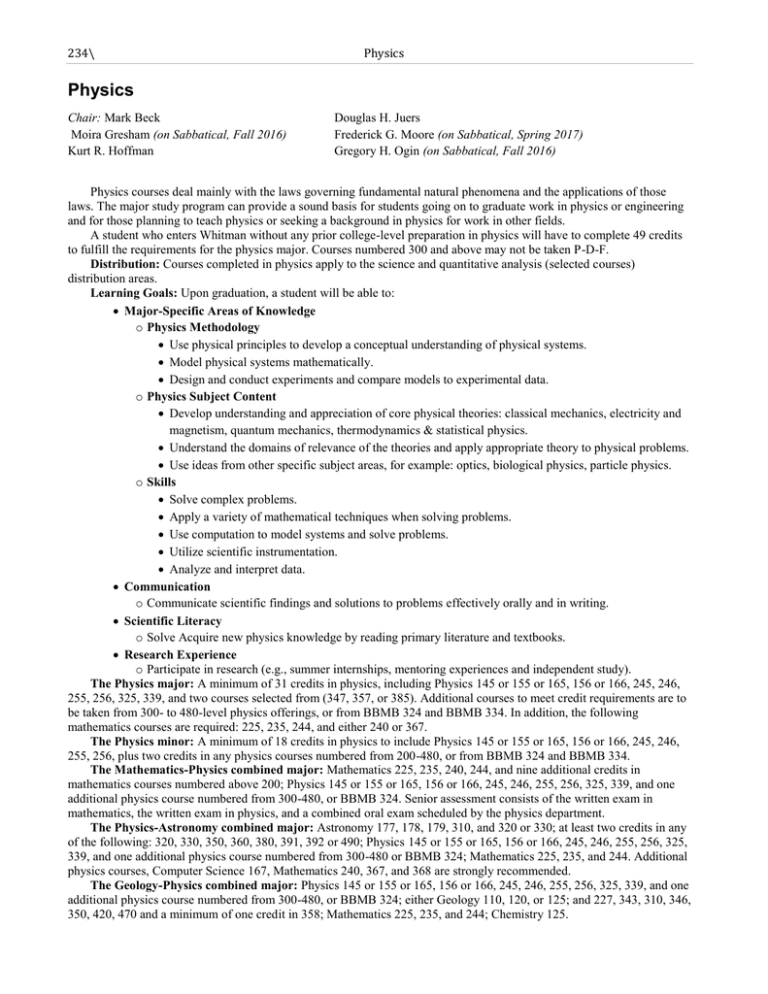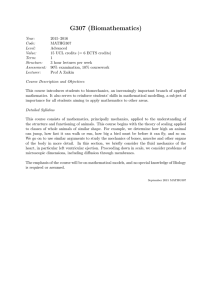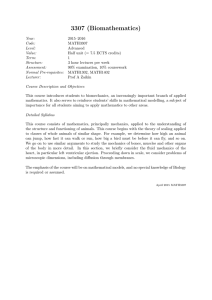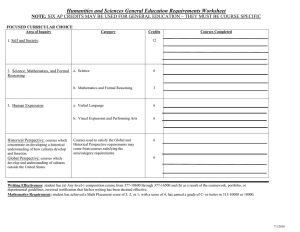Physics - Whitman College
advertisement

234\ Physics Physics Chair: Mark Beck Moira Gresham (on Sabbatical, Fall 2016) Kurt R. Hoffman Douglas H. Juers Frederick G. Moore (on Sabbatical, Spring 2017) Gregory H. Ogin (on Sabbatical, Fall 2016) Physics courses deal mainly with the laws governing fundamental natural phenomena and the applications of those laws. The major study program can provide a sound basis for students going on to graduate work in physics or engineering and for those planning to teach physics or seeking a background in physics for work in other fields. A student who enters Whitman without any prior college-level preparation in physics will have to complete 49 credits to fulfill the requirements for the physics major. Courses numbered 300 and above may not be taken P-D-F. Distribution: Courses completed in physics apply to the science and quantitative analysis (selected courses) distribution areas. Learning Goals: Upon graduation, a student will be able to: Major-Specific Areas of Knowledge o Physics Methodology Use physical principles to develop a conceptual understanding of physical systems. Model physical systems mathematically. Design and conduct experiments and compare models to experimental data. o Physics Subject Content Develop understanding and appreciation of core physical theories: classical mechanics, electricity and magnetism, quantum mechanics, thermodynamics & statistical physics. Understand the domains of relevance of the theories and apply appropriate theory to physical problems. Use ideas from other specific subject areas, for example: optics, biological physics, particle physics. o Skills Solve complex problems. Apply a variety of mathematical techniques when solving problems. Use computation to model systems and solve problems. Utilize scientific instrumentation. Analyze and interpret data. Communication o Communicate scientific findings and solutions to problems effectively orally and in writing. Scientific Literacy o Solve Acquire new physics knowledge by reading primary literature and textbooks. Research Experience o Participate in research (e.g., summer internships, mentoring experiences and independent study). The Physics major: A minimum of 31 credits in physics, including Physics 145 or 155 or 165, 156 or 166, 245, 246, 255, 256, 325, 339, and two courses selected from (347, 357, or 385). Additional courses to meet credit requirements are to be taken from 300- to 480-level physics offerings, or from BBMB 324 and BBMB 334. In addition, the following mathematics courses are required: 225, 235, 244, and either 240 or 367. The Physics minor: A minimum of 18 credits in physics to include Physics 145 or 155 or 165, 156 or 166, 245, 246, 255, 256, plus two credits in any physics courses numbered from 200-480, or from BBMB 324 and BBMB 334. The Mathematics-Physics combined major: Mathematics 225, 235, 240, 244, and nine additional credits in mathematics courses numbered above 200; Physics 145 or 155 or 165, 156 or 166, 245, 246, 255, 256, 325, 339, and one additional physics course numbered from 300-480, or BBMB 324. Senior assessment consists of the written exam in mathematics, the written exam in physics, and a combined oral exam scheduled by the physics department. The Physics-Astronomy combined major: Astronomy 177, 178, 179, 310, and 320 or 330; at least two credits in any of the following: 320, 330, 350, 360, 380, 391, 392 or 490; Physics 145 or 155 or 165, 156 or 166, 245, 246, 255, 256, 325, 339, and one additional physics course numbered from 300-480 or BBMB 324; Mathematics 225, 235, and 244. Additional physics courses, Computer Science 167, Mathematics 240, 367, and 368 are strongly recommended. The Geology-Physics combined major: Physics 145 or 155 or 165, 156 or 166, 245, 246, 255, 256, 325, 339, and one additional physics course numbered from 300-480, or BBMB 324; either Geology 110, 120, or 125; and 227, 343, 310, 346, 350, 420, 470 and a minimum of one credit in 358; Mathematics 225, 235, and 244; Chemistry 125. Physics /235 The Physics-Environmental Studies combined major: The requirements are fully described in the Environmental Studies section of the catalog. The Physics/Pre-engineering (3/2 Engineering) program: The requirements are fully described in the Combined Plans section of the catalog. Program Planning: A typical program of the required physics courses and mathematics requirements for students taking a physics major with no advanced placement in calculus is as follows: I. First year: Physics 145 or 155 or 165, Mathematics 125 (seven credits); Physics 156 or 166, Mathematics 126 (seven credits). II. Second year: Physics 245, 255, Mathematics 225, 235 (eight credits); Physics 246, 256, Mathematics 244 (eight credits). III. Third year: Physics 325, 339, Mathematics 240 (nine credits); Physics 347 (three credits). IV. Fourth year: Physics 385. Note that additional physics courses must be taken during the third and fourth years to meet the minimum credit requirement. Every effort will be made to offer courses required for the major and combined majors every year. Upperlevel electives will typically be offered in alternate years. Students seriously considering graduate studies in physics or a physics-related field are encouraged to consult with their major adviser to design a course of study that will be best suited to their goals. Among other electives for the physics major, Computer Science 167 is highly recommended. A year of chemistry also is recommended. Chemistry 345, Mathematics 349, 368, or 467 can be especially useful for physicists. In the final semester of the senior year the student must pass a senior assessment consisting of a written exam and a one-hour oral exam. Non-major Courses: Courses numbered below 110 are intended for students majoring in fields other than science. General Physics: There are two versions of the introductory general physics sequence. Physics 145/146 is intended for students planning no further study in physics. Physics 155/156 is intended for students planning to take upper level physics courses, including physics majors, physics combined majors, 3-2 engineering majors and BBMB majors. 101, 102 Special Topics 3 Course designed for nonscience majors to explore some basic concepts of physics and their applications through readings, discussion, problem-solving, and occasional laboratory activities. Possible course titles include: How Things Work, Light and Color, and Physical Science. The topic for each course will be designated prior to registration for the semester in which the course will be taught. Students with AP credit for physics at Whitman or who have received credit for Whitman’s Physics 145 or higher cannot receive credit for Physics 101 or 102. Any current offerings follow. 103 Sound and Music 3, x Hoffman This course will provide students with conceptual, quantitative, and laboratory based analysis of sound, musical instruments, music recording and storage, and room acoustics. Through detailed analysis of musical instruments as physical systems, students will develop an understanding of important physical concepts including sound waves, harmonic oscillators, energy, standing waves, resonance, and more. The course will culminate in student projects that may include building an instrument, designing and executing an experimental investigation related to acoustics, or extending course material to a new area of inquiry through a research paper. The course will meet four hours a week with two of those hours typically devoted to laboratory based learning. 105 Energy and the Environment 3; not offered 2016-17 This course examines the physical principles that govern energy transformations. It will focus on the use of energy in the world, specifically its production, transportation, consumption and the implications this use has for the environment. Topics addressed will range from the mechanical to electricity and magnetism and from thermodynamics to atomic/nuclear physics. Energy resources both new and traditional (fuel cells versus oil) will be addressed as well as environmental issues ranging from global warming to the disposal of radioactive waste. This course assumes a basic familiarity with algebra. 236\ Physics 115, 116 Contemporary Issues in Physics 1; not offered 2016-17 This course serves as an introduction to contemporary issues and topics in physics. Through readings and discussions students will explore the activities of modern-day physicists. Although this course is intended for students planning to continue toward a physics or physics-related major, it is an excellent course for students wanting a better understanding of what physics is “all about” and how it is done, as a profession, at the beginning of the 21st century. Corequisites: for Physics 115: Physics 155 or 165; for Physics 116: Physics 156 or 166; or consent of instructor. Physics 115 and 116 each may be taken once for a total of two credits. No examinations. Graded credit/no credit only. Does not fulfill science or quantitative analysis distribution. 135, 136 Introductory Physics Laboratory x, 1 Beck A series of experiments to illustrate experimental methods, basic measuring techniques and equipment, and important phenomena. Offered to facilitate awarding of AP credit on the AP Physics C exam and to offer an introductory laboratory experience for students who have taken introductory physics without a laboratory at another institution. No examinations. Graded credit/no credit only. Prerequisite: consent of instructor. 145 General Physics I – with Applications to Life and Earth Sciences 4, x Hoffman This course focuses on classical mechanics: kinematics, Newton's Laws, energy and momentum conservation, torques, fluids, and waves. Examples and problems will focus on applications of physical principles to life and earth science fields to a greater extent than in Physics 155. Students enrolling in this course also will be required to enroll in an associated laboratory course (Physics 175). Three 50-minute or two 80-minute class meetings and two 90-minute laboratory meetings per week. Evaluation based on homework, laboratory reports, and examinations. Pre- or corequisite: Mathematics 125. 146 General Physics II – with Applications to Life and Earth Sciences x, 4 Hoffman This course is a continuation of the course Physics 145. Topics studied include electricity and magnetism, circuits, optics, nuclear and atomic physics. Examples and problems will focus on applications of physical principles to life and earth science fields to a greater extent than in Physics 156. Not intended for students planning to take upper level physics or biophysics. Students enrolling in Physics 146 also will be required to enroll in an associated laboratory course (Physics 176). Three 50-minute or two 80-minute class meetings and two 90-minute laboratory meetings per week. Evaluation based on homework, laboratory reports, and examinations. Prerequisite: Physics 145, 155 or 165. Pre- or corequisite: Mathematics 126. 155 General Physics I 4, x Juers, Moore This course focuses on classical mechanics: kinematics, Newton’s laws of motion, energy and momentum conservation, and waves. Students enrolling in this course also will be required to enroll in an associated laboratory course (Physics 175). Three 50-minute or two 80-minute class meetings and two 90-minute laboratory meetings per week. Evaluation based on homework, laboratory reports, and examinations. Pre- or corequisite: Mathematics 125. 156 General Physics II x, 4 Gresham, Ogin This course is a continuation of the course Physics 155. Topics studied include electricity and magnetism, circuits, optics, plus brief introductions to more contemporary topics such as special relativity or quantum physics. Students enrolling in Physics 156 also will be required to enroll in an associated laboratory course (Physics 176). Three 50-minute or two 80minute class meetings and two 90-minute laboratory meetings per week. Evaluation based on homework, laboratory reports, and examinations. Prerequisite: Physics 145, 155 or 165. Pre- or corequisite: Mathematics 126. 165 Advanced General Physics I 4; not offered 2016-17 This course focuses on classical mechanics: kinematics, Newtonian mechanics, energy and momentum conservation, and waves. The course covers material similar to that in Physics 155, but at a more advanced level and with more use of calculus. Three 50-minute class meetings and two 90-minute laboratory meetings per week. Evaluation based on Physics /237 homework, laboratory reports, and examinations. Prerequisites: Mathematics 125 and high school physics. Pre- or corequisite: Mathematics 126. 166 Advanced General Physics II 4; not offered 2016-17 This course is a continuation of the course Physics 165. Topics studied include electricity and magnetism, circuits, optics, fluids, plus brief introductions to more contemporary topics such as special relativity or quantum physics. The course covers material similar to that in Physics 156, but at a more advanced level and with more use of calculus. Three 50-minute class meetings and two 90-minute laboratory meetings per week. Evaluation based on homework, laboratory reports, and examinations. Prerequisites: Physics 155 or 165; Mathematics 126. Pre- or corequisite: Mathematics 225. 245 Twentieth Century Physics I 3, x Beck Topics include thermodynamics, special relativity, nuclear decay and radiation, wave nature of particles, introduction to the Schrodinger Equation: infinite well. Mathematical methods relevant to these areas of inquiry will be discussed: probability theory, differential equations. Prerequisites: Physics 156 or 166; Mathematics 126. Corequisite: Mathematics 225. 246 Waves, Electronics, and Quantum Mechanics x, 3 Beck The course will explore electronic circuit theory and wave mechanics with a focus on the mathematical methods for solving differential equations. Specific content addressed includes coupled oscillators, damped-driven oscillators, fourier analysis, linear circuit theory, resonance circuits. Specific applications of the results to be explored include atomic, molecular, and particle physics; op-amps and digital circuits. Prerequisites: Physics 245 and Mathematics 225. Corequisite: Mathematics 244. 255 Twentieth Century Physics Laboratory 1, x Moore Experimental investigations of a variety of phenomena relating to the Physics 245 course. Experimental topics studied include: thermodynamics, nuclear decay and radiation, photoelectric effect and standing waves. Emphasis on experimental technique, problem-solving, data analysis, and scientific writing. No examinations. One three-hour laboratory per week. Pre- or corequisites: Physics 245, 246. 256 Electronics and Waves Laboratory x, 1 Hoffman Experimental investigations of a variety of phenomena relating to the Physics 246 course. The focus of the laboratory will be two-fold. Students will construct and analyze electronic filter and resonance circuits. In addition, students will explore wave phenomena related to coupled oscillators, driven oscillators, and scattering theory. The emphasis will be on experimental technique, problem-solving, data analysis, and scientific writing. No examinations. One three-hour laboratory per week. Prerequisite: Physics 255. Corequisite: Physics 246. 325 Electricity and Magnetism 3, x Moore Electrostatics, electric and magnetic properties of materials, electromagnetic theory. Maxwell’s equations, electromagnetic waves, boundary value problems. Includes mathematical methods of wide use in physics. Lectures and problems. Prerequisites: Physics 246 and Mathematics 244. 339 Advanced Laboratory x, 3 Ogin Experimental investigations of sophisticated analog and digital circuitry and the fundamental physics underpinning their operation. Students will employ programming tools to automate and enhance aspects of experimental techniques and subsequent analysis of data. Students will design and implement extensions to experiments in classical and modern physics with an emphasis on laboratory technique, technical and scientific writing, and analysis. The course will be a combination of lecture and laboratory activities meeting two days a week. Prerequisite: Physics 256. 238\ Physics 347 Classical Mechanics 3, x Juers Non-inertial coordinate systems, systems of particles, rigid body motion. Lagrangian mechanics, normal modes of vibration, and Hamiltonian mechanics. Includes mathematical methods of wide use in physics. Lectures and problems. Three lectures per week. Prerequisite: Physics 246. 348 Optics 3; not offered 2016-17 Modern physical optics including a study of the propagation of light, coherence and interference, diffraction, image formation. Fourier optics, spatial filtering, polarization, the optical activity of solids, the quantum nature of light, lasers, and holography. Lectures and problems. Three lectures per week. Prerequisite: Physics 246. 357 Thermal Physics 3; not offered 2016-17 Thermodynamics, entropy, thermodynamic potentials, phase changes, chemical reactions, kinetic theory, distributions, phase space, transport phenomena, fluctuations; classical and quantum statistical mechanics, application to solids, radiation, superfluids, lasers, and astrophysics. Lectures, discussion, and problems. Prerequisite: Physics 246. 377 Particle Physics x, 3 Gresham From electrons to quarks to neutrinos to the Higgs mechanism, this course centers on a quantitative introduction to the Standard Model of particle physics---the well-tested model that describes all elementary particles and non-gravitational forces discovered up until the present. A significant portion of the class will be dedicated to learning and using the Feynman Calculus to calculate observable properties of elementary particle interactions. The course will end with a description of the Higgs mechanism and a discussion of some of the most pressing outstanding questions in particle physics. Prerequisite: Physics 246. Recommended corequisite: Mathematics 240. 385 Quantum Mechanics I x, 4 Beck; Lab: Ogin This course begins with the quantum description of some two-dimensional systems (photon polarization and spin-1/2 particles) using the formalism of matrix mechanics. The course then moves on to cover two-particle systems, time evolution, and continuous systems (e.g., the harmonic oscillator). Three hours of lecture each week, and three hours of laboratory every other week. Laboratories include single photon interference, and tests of local realism (e.g., Bell inequalities). Prerequisites: Physics 246, 256 and Mathematics 244. Recommended prerequisite: Mathematics 240 or 367. 451, 452 Advanced Topics in Physics 1-3 Specialized topics in physics such as: spectroscopic techniques, semiconductor physics, laser physics, plasma physics, advanced instrumentation techniques. Prerequisite: consent of instructor. Any current offerings follow. 481, 482 Seminar 1; not offered 2016-17 Oral reports by students on individual reading and research, talks by faculty and visiting physicists, group discussion of readings of general interest. Students submit notes on talks and their own lecture notes. No examinations. One meeting per week. Graded credit/no credit. Prerequisite: consent of instructor. 483, 484 Independent Study 1-3, 1-3 Staff Experimental or theoretical research or reading in an area of physics not covered in regular courses, under supervision of a faculty member. Maximum six credits. Prerequisite: consent of instructor. 490 Thesis 3, 3 Staff Preparation of a thesis. Physics 498 Honors Thesis 3, 3 Staff Designed to further independent research or projects leading to the preparation of an undergraduate thesis or a project report. Required of and limited to senior honors candidates in physics. Prerequisite: admission to honors candidacy. /239




